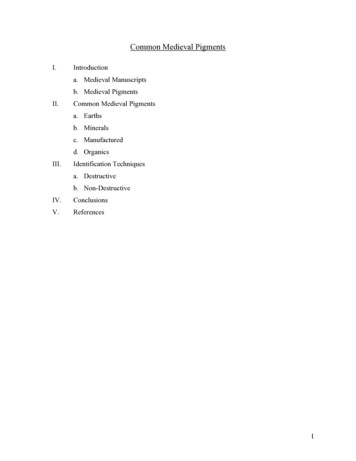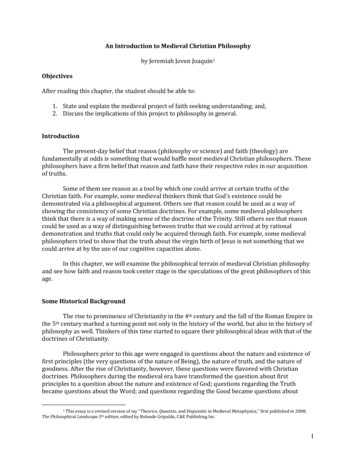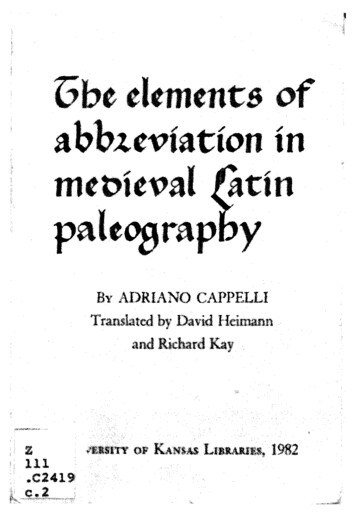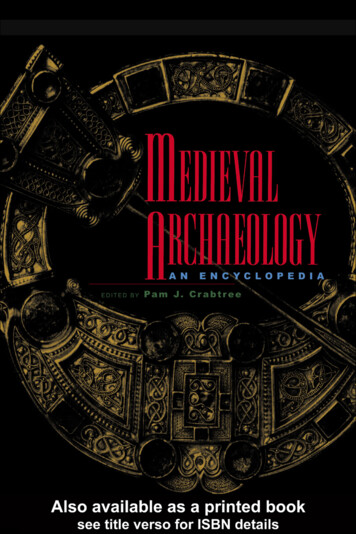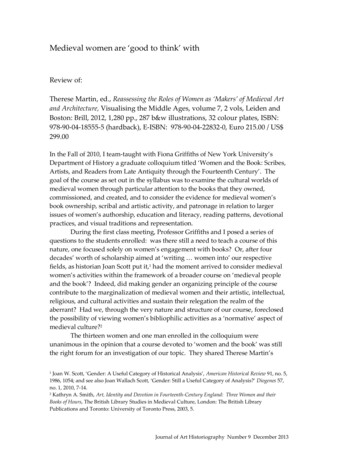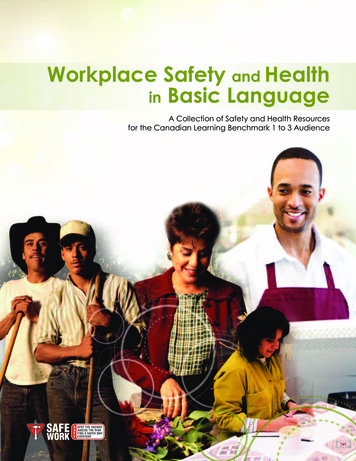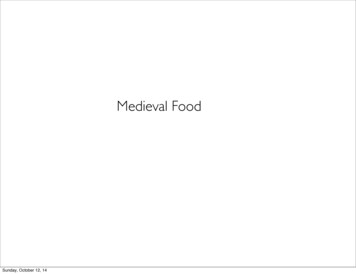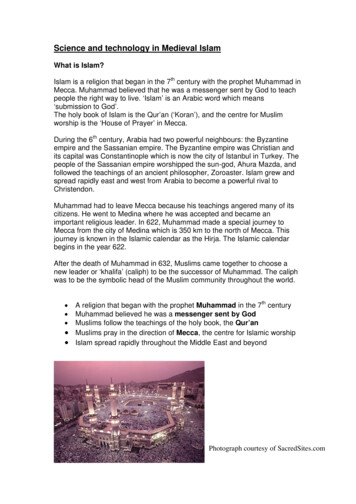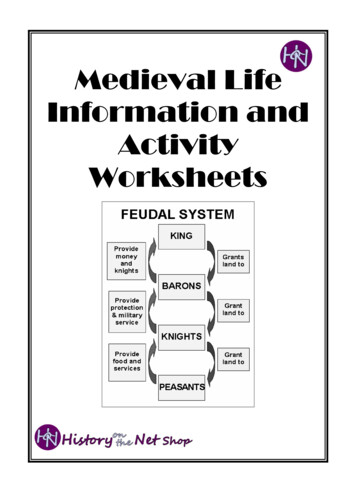
Transcription
Medieval LifeInformation andActivityWorksheets
WorksheetsThis booklet has been printed and soldby History on the Net to be used as ateaching resourceThe purchaser is entitled to photocopythese pages for personal, educational ornon-profit usage provided that thecopyright notice is not removedThe copyright of this booklet and itscontents remains the property of H YWheeler and History on the Net 2008 H Y Wheeler History on the Net
Section 1The Feudal SystemPage 1, 2Page 3Page 4, 5Page 6Page 7- The Feudal System information pages- Suggested Activities- Feudal System Card Sort- Feudal System wordsearch- Feudal System true or falseSection 2How Did Medieval People Live?Page 8Page 9Page 10Page 11Page 12Page 13,14Page 15Page 16Page 17Page 18Page 19Page 20,21Page 22Page 23Page 24Page 25Page 26Page 27Page 28Page 29Page 30- Housing – Noblemen and Women- Housing – Peasants- Making a Medieval House- Clothing – Noblemen and Women- Clothing – Peasants- Food – Noblemen and Women- Food - Peasants- Daily Routine - Noblemen- Peasants – The Farming Year- Suggested Activities- Medieval Rich and Poor comparison table- Writing frames- The Farming Year blank table- Daily Routines timeline activity- Housing wordsearch and word sort- Clothing quiz- Clothing wordsearch- Medieval Food anagrams- Medieval Food wordsearch- Farming Year wordsearch- Medieval Life crosswordMedieval Life Information & Activity Worksheets 2006 H Y Wheelerwww.historyonthenet.com
Section 3Crime and PunishmentPage 31Page 32Page 33Page 34Page 35Page 36-40Page 41Page 42- Punishment- Guilty or Not Guilty- Suggested Activities- Understanding Medieval Crime and Punishment- The Manorial Court – You Decide- Manorial Court Drama- Crime and Punishment wordsearch- Crime and Punishment anagramsSection 4Medieval ReligionPage 43,44Page 45Page 46Page 47Page 48Page 49Page 50Page 51Page 52- Medieval Religion information pages- Picture Source- Picture Source analysis- Suggested Activities- Medieval Church Who’s Who- Medieval Religion questions- Heaven and Hell drawing frame- Writing frame- Medieval Religion wordsearchSection 5Solutions to Crosswords, Wordsearches. Anagrams andquiz sheetsMedieval Life Information & Activity Worksheets 2006 H Y Wheelerwww.historyonthenet.com
The Feudal System was introducedto England following the invasionand conquest of the country byWilliam I (The Conqueror).The system had been used inFrance by the Normans from thetime they first settled there in about900AD.It was a simple, but effectivesystem, where all land was ownedby the king. One quarter was keptby the king as his personalproperty, some was given to thechurch and the rest was leased outunder strict controls.Each group of people had certainduties and obligations to perform.The KingThe king was in complete control. He owned allthe land in the country and would only allowpeople he could trust to lease land from him.Men that were selected to lease land had to swearan oath to remain faithful to the King at all times.These men were known as barons. They werewealthy, powerful and had complete control of theland they leased from the King.Page 1Medieval Life Information & Activity Worksheets 2007 H Y Wheelerwww.historyonthenet.com
BaronsThe land that barons leased from the King was known as amanor and the barons were called the Lord of the Manor. Theykept as much land as they wanted for their own use anddivided the rest among their knights.The barons were in complete control of this land. Theyestablished their own system of justice, minted their ownmoney and set their own taxes.In return for the land they had been given by the king, thebarons had to serve on the royal council, pay rent and providethe king with knights for military service when he demanded it.They also had to provide lodging and food for the king and hiscourt when they travelled around the country.KnightsKnights were given land by a baron. In returnfor the land they had to provide military servicewhen demanded by the king. They also had toprotect the baron and his family, as well as themanor, from attack.The knights kept as much of the land as theywished for their own personal use anddistributed the rest to peasants.PeasantsPeasants, sometimes known as serfs or villeins, weregiven land by knights. In return they had to provide theknight with free labour, food and service whenever itwas demanded.Peasants had no rights. They were not allowed to leavethe Manor and even had to ask for permission beforethey could marry.Page 2Medieval Life Information & Activity Worksheets 2007 H Y Wheelerwww.historyonthenet.com
Suggested Activities1. Feudal System card sort2. Sort pupils to resemble the feudal system3. Feudal System wordsearch4. Feudal System true or false quizPage 3Medieval Life Information & Activity Worksheets 2007 H Y Wheelerwww.historyonthenet.com
KnightPeasantKingBaronFeudal System Card SortI lease land tobaronsI lease land toknightsI lease land topeasantsI lease landfrom the kingI lease landfrom the baronI lease landfrom the knightPage 4Medieval Life Information & Activity Worksheets 2007 H Y Wheelerwww.historyonthenet.com
Feudal System Card SortI have to serve onthe Royal CouncilI have to pay rentto the kingI have to protectthe baron and themanorI have to fight forthe king when thebaron tells me toI have to work forthe knight for nopayI have to give theknight foodI am the richestperson in the landI am richI have enoughmoneyI am poorPage 5Medieval Life Information & Activity Worksheets 2007 H Y Wheelerwww.historyonthenet.com
The Feudal System INGOATHPEASANTPROTECTKNIGHTMANORFOODLANDPage 6Medieval Life Information & Activity Worksheets 2007 H Y Wheelerwww.historyonthenet.com
Feudal System True or FalseDecide which of the following statements about the Feudal System are true andwhich are false1. The Normans introduced the Feudal System to EnglandTrueFalse2. The king owned all the landTrueFalse3. Barons leased land from knightsTrueFalse4. Peasants were richer than baronsTrueFalse5. Knights had to provide military serviceTrueFalse6. Knights gave food to peasantsTrueFalse7. Peasants fought for the kingTrueFalse8. Barons served on the Royal CouncilTrueFalse9. Peasants paid rent to the kingTrueFalse10. Peasants had to give food to knightsTrueFalse11. Knights leased land from baronsTrueFalse12. Peasants were very poorTrueFalsePage 7Medieval Life Information & Activity Worksheets 2007 H Y Wheelerwww.historyonthenet.com
HousingNoblemen and WomenEarly Medieval PeriodThe houses of the rich were made out ofstone and had thatched roofs.This early medieval cottage would have beeninhabited by the Lord of the Manor and hisfamily and servants. It has two rooms. Theroom on the left of the picture would havebeen the main living and sleeping area for thefamily and their servants.It has a small window and a place cut into the floor for the hearth. There is asmall hole in the roof above the hearth to let smoke escape. The other smallerroom contains a stone oven.The animals would have been housed in a separate building, probably awooden barn, and another building would have been used to store crops whichwere grown on the land around the house.Later Medieval PeriodThe houses of the very rich were made out of brick, but because brick wasvery expensive most chose to build the half-timbered houses that are nowcommonly referred to as Tudor houses.Blackened oak wood was used tomake the framework and plaster wasused to fill the spaces.Roofs were tiled and some houses nowhad glass windows and chimneys.Houses had two or more floors andservants slept in the upper rooms.Most houses had stables where theirhorses were kept.Those who lived in the country grew their own fruit and vegetables and keptanimals for meat and dairy produce. Rich merchants that lived in towns wouldhave purchased food from the local marketplace.Page 8Medieval Life Information & Activity Worksheets 2007 H Y Wheelerwww.historyonthenet.com
PeasantsEarly Medieval PeriodThose that were too poor to pay someone to build a house for them had tomake their houses themselves. Some people were too poor to pay for buildingmaterials and had to use whatever they could find to construct a hut that wouldprovide shelter.The simplest houses were made from sticks and straw.These basic huts did not offer much protection. Theywere easy to attack and could fall apart if the weatherwas severe. There was only enough room inside for oneor two straw mattresses and food had to be cookedoutside.Later Medieval PeriodThe Black Death of 1348 killed a large number of the peasant population. Thismeant that there were not enough peasants to work in the fields. Landownersdesperate for workers to harvest their crops began offering wages to anyonewho would work on their land. Peasants were, for the first time, able to offertheir services to the landowner that would pay the highest wage.With more money, peasants were able to afford better housing and many nowlived in wattle and daub houses.These houses offered much better protection and therewas space inside for the animals. Generally the familylived in one main room and a section at one end wasreserved for the animals.The hearth (fireplace) would be in the centre of theliving area and would provide heat for warmth andcooking.There were no windows or chimney so these houseswould be dark, smokey and smelly.Page 9Medieval Life Information & Activity Worksheets 2007 H Y Wheelerwww.historyonthenet.com
Making a Medieval HouseStick and Straw Hut1231. Long sticks were hammered into the ground at an angle and tied at thetop. Another stick was placed across the top and tied into place.2. More sticks were tied into place to make a framework and doorway.3. Smaller sticks were tied to fill in the gaps and then mud and straw ordried grass was woven across the sticks.Wattle and Daub House1231. A framework was made out of timber2. More tmber was added to the framework and the spaces between filledwith wattle (twigs woven together).3. The wattle was daubed (covered) with wet mud which dried to form ahard wall. The roof was thatched with straw.Page 10Medieval Life Information & Activity Worksheets 2007 H Y Wheelerwww.historyonthenet.com
ClothingWhat you wore depended on who you were in the medieval period.If you were rich you would probably own a variety of clothes, in the latest stylesand colours. If you were a poor peasant, you may only own one tunic.Although it was possible to obtain silks and other luxurious materials fromabroad, they were very expensive. Most clothing was therefore made out ofwool which was cheap and easy to obtain. This meant that clothing in themedieval period was itchy, difficult to wash and dry and very hot in thesummer.Noblemen and WomenEarly Medieval PeriodThese pictures (right) show the costume wornby the rich during the early medieval period.The man is wearing a woollen tunic, belted atthe waist that has been embroidered aroundthe hem and sleeves. Over this he has awoollen cloak fastened with a brooch.The man's wife is wearing a woollen dress, tiedat the waist over a white linen underskirt. Overthis she has a woollen cloak. Her headdress ismade out of linen and is held in place with aheadband.Later Medieval PeriodThis famous Jan Van Eyck portrait painted in 1435shows a rich nobleman and his wife dressed in thetypical fashion of the day.The man is wearing a fur-trimmed velvet gown overa black padded long shirt that has gold embroideryaround the edges. He has black stockings to coverhis legs. The large hat is a sign of his wealth.The man's wife is wearing a green woollen dresstrimmed with cream coloured fur that is belted veryhigh. Underneath the dress she has another dressmade out of blue material. Her headdress is madeout of fine expensive linen.Page 11Medieval Life Information & Activity Worksheets 2007 H Y Wheelerwww.historyonthenet.com
PeasantsEarly Medieval PeriodThe clothing of peasantspractical and not decorated.wasbasic,The man is wearing a short woollen tunicbelted at the waist over short woollentrousers. He is wearing a small hat over awoollen cowl and boots on his feet.The man’s wife is wearing a woollen dressover a woollen underskirt. She has awoollen cowl to protect her head andshoulders and boots on her feet.Later Medieval PeriodThis picture, from a painting byBruegel, shows medieval peasantsenjoying a local festival. They are,therefore, wearing their best clothes.The man is wearing a short woollenjacket over a woollen tunic. He iswearing stockings and shoes on hisfeet and has a small cap on his head.The man’s partner is wearing awoollen dress over a woollenunderskirt. She is also wearing a linenheaddress.Page 12Medieval Life Information & Activity Worksheets 2007 H Y Wheelerwww.historyonthenet.com
FoodNoblemen and WomenThis medieval woodcarving from the 14th century shows the King at a banquet.One serving boy offers the King first choice of wine or ale poured from a jugwhile another offers him the first cut of meat. The other people at the banquetwill be served in turn according to their rank and the least important people willget whatever remains.The nobles always ate well, even during winter. Unlike most of the people wholived on the manor, nobles could afford to buy salt to preserve meat all theyear round. They could also afford pepper to spice tasteless food or foodwhich was beginning to go bad.Meat – beef, pork, lamb, chicken or goose was eaten daily. It was generallyroasted or made into a stew thickened with grain and vegetables. Meat wasnot allowed to be eaten on Fridays and on this day fish – salmon, herring, troutor other freshwater fish would be eaten instead.Bread would be served at most meals and cheese and butter would also beavailable. A variety of fruits would be served after the main course.Plates were made out of wood but sometimes they used large slices of day-oldbread as plates for the meat and sometimes they ate out of bowls. Althoughthey had knives and spoons, there were no forks, so people used their fingersa great deal.Page 13Medieval Life Information & Activity Worksheets 2007 H Y Wheelerwww.historyonthenet.com
A Typical Daily MenuBreakfastThis would be eaten early, probably around 6 am and would include whitebread, cheese, cold meat and fresh fruit served with ale or wine.DinnerThis would be served between 11 am and 1 pm. This was generally twocourses. The first course would consist of meat, fish, pastries and white breadserved with wine or ale. This would be followed by fruit, cheese and nuts.SupperThis would be eaten in the early evening and would include similar foods tothose served at dinner.This picture shows food being prepared for the lord’s dinner.A kitchen boy can be seen roasting a pig over the kitchen fire. The meathanging to the right of the fire is ready to be cooked.In the foreground two women are preparing food. The one on the left is using amillstone to grind grain into flour while the other is using a mortar and pestle togrind herbs or spices.Page 14Medieval Life Information & Activity Worksheets 2007 H Y Wheelerwww.historyonthenet.com
PeasantsThe peasants’ main food was a darkbread made out of rye grain.They ate a kind of stew calledpottage made from the peas, beansand onions that they grew in theirgardens.Sweet foods eaten by peasantswere those that grew naturally –apples, pears, berries and nuts.They also ate honey that theycollected from the woods.Most peasants kept pigs. As pigs could survive on acorns that could be foundin the woods they were cheap and easy to keep.They could hunt rabbits or hares but might be punished for this by their lord.A Typical Daily MenuBreakfastThis would be eaten early, probably as soon as the sun rose and wouldinclude dark bread, cheese, cold meat and fresh fruit.DinnerThis would be eaten in the fields between 10 am and noon and usuallyconsisted of dark bread and cheese with ale to drink.SupperThis would be eaten at around sunset and would consist of a pottage madefrom vegetables and meat if available, served with dark bread and ale.Peasants cooked and prepared their own food overopen fires.Bread was baked in the baker’s oven.Page 15Medieval Life Information & Activity Worksheets 2007 H Y Wheelerwww.historyonthenet.com
Daily RoutinesNoblemenThe daily routine for noblemen was the same throughout theyear.The day would begin at sunrise when, if not already awakethe nobleman would be woken by his servants bringingwater for him to wash and shave.When he was dressed he would attend mass in his chapel.This would be followed by the first meal of the day.After breakfast he would turn his attention to business. Hewould receive reports about the state of the land and anyproblems concerning crop production or harvest.Time would also be spent on the financial aspect of runningthe manor – paying taxes and bills and ensuring that tenantshad paid their rent.Certain days of the year were also set aside for the lord to hear complaints andgrievances from his tenants and also to settle any disputers.At around mid-morning prayers would be heard before the main meal of theday, dinner.After dinner the nobleman would spend time hunting or riding around hisestate. He may also spend time practising with his weapons.At sunset there would be prayers followed by supper in the great hall. Jugglersor minstrels would provide evening entertainment.Prayers would be heard again before bedtime.Page 16Medieval Life Information & Activity Worksheets 2007 H Y Wheelerwww.historyonthenet.com
PeasantsPeasants rose before sunrise and began their day with breakfast. They wouldwork on the land from sunrise to sunset stopping for lunch at around noon.They would eat their evening meal soon after sunset and go to bed as soon asit was dark.The actual tasks carried out by peasants were governed by the farming year.The Farming YearPage 17Medieval Life Information & Activity Worksheets 2007 H Y Wheelerwww.historyonthenet.com
Suggested Activities1. Produce project or PowerPoint presentation to show the differencesbetween the lives of the rich and poor2. Imagine you are either a rich or a poor person. Write a letter explainingwhat your life is like; what you like about it the most and what you wouldlike to change3. Use http://www.historyonthenet.com/Medieval Life/farming.htm to completeFarming Year table4. Daily Routine timeline activity5. Design and make a medieval house6. Use wordsearches, quiz, anagram and crossword for starter, plenary orintroductory activitiesPage 18Medieval Life Information & Activity Worksheets 2007 H Y Wheelerwww.historyonthenet.com
PoorDailyRoutineFoodClothingHousingRichThe Lives of the Medieval Rich and PoorPage 19Medieval Life Information & Activity Worksheets 2007 H Y Wheelerwww.historyonthenet.com
Page 20Medieval Life Information & Activity Worksheets 2007 H Y Wheelerwww.historyonthenet.com
Page 21Medieval Life Information & Activity Worksheets 2007 H Y Wheelerwww.historyonthenet.com
The Farming age 22Medieval Life Information & Activity Worksheets 2007 H Y Wheelerwww.historyonthenet.com
Timeline ActivityComplete this timeline to show the daily routine of a nobleman and a peasant6 a.m.Gets upGets upSunrise8 a.m.Nobleman10 a.m.Peasant12 Noon2 p.m.4 p.m.6 p.m.Sunset8 p.m.10 p.m.Page 23Medieval Life Information & Activity Worksheets 2007 H Y Wheelerwww.historyonthenet.com
Housing WordsearchUPSTAIRSANIMALSWINDOWSTRAWDAUBEarly MedievalPoorSERVANTSSTABLESHEARTHROOMSDOORLate MedievalPoorSHELTERWATTLESMOKEYSTONEOVENEarly MedievalRichCHIMNEYTIMBERSTICKBRICKLate MedievalRichPage 24Medieval Life Information & Activity Worksheets 2007 H Y Wheelerwww.historyonthenet.com
Clothing Quiz1. Choose the correct caption for the following picturesabEarly Medieval richEarly Medieval richEarly Medieval poorEarly Medieval poorLate Medieval richLate Medieval richLate Medieval poorLate Medieval poordEarly Medieval richcEarly Medieval richEarly Medieval poorEarly Medieval poorLate Medieval richLate Medieval richLate Medieval poorLate Medieval poor2. Choose the correct ending to the following sentencesa. Most clothing was made out ofb. A large hat was a sign ofLinenSilkA large headWealthWoolCottonPovertyA bad hat makerc. Peasants’ clothing wasd. Clothing in the Medieval periodwasEmbroideredLuxuriousHot and heavyPatternedPlain & practicalCool and lightEasy to wash3. Choose the correct word for the following definitionsa. Item of clothing worn over the head and shouldersb. Sleeved, belted garment worn by menc. Jewellery item used to fasten a cloakd. Usually made from linen, worn over the heade. Leg covering worn by menPage 25Medieval Life Information & Activity Worksheets 2007 H Y Wheelerwww.historyonthenet.com
Clothing ge 26Medieval Life Information & Activity Worksheets 2007 H Y Wheelerwww.historyonthenet.com
Medieval Food AnagramsUnscramble the letters to make a word connected to Medieval foodBev eats legPet goatFur itBeardUppersBent quaIf KenNo sopBaker’s fatRed innTeamPicesPage 27Medieval Life Information & Activity Worksheets 2007 H Y Wheelerwww.historyonthenet.com
Medieval Food EATALEPage 28Medieval Life Information & Activity Worksheets 2007 H Y Wheelerwww.historyonthenet.com
Farming Year IRWINNOWPRUNEWEEDSOWPage 29Medieval Life Information & Activity Worksheets 2007 H Y Wheelerwww.historyonthenet.com
Medieval Life Crossword12345678109111213Across3 Used to thatch the roof of a house (5)4 Jewellery item used to fasten a cloak (6)10 The simplest houses were made of this (6,3,5)12 Most clothing was made out of this material (4)13 Last meal of the day (6)Down1 Eaten on a Friday (4)2 Work done by peasants depended on this (7,4)5 Food eaten daily by the rich and poor (5)6 Twigs woven together (6)7 Cutlery item not available in the Medieval period (4)8 Where horses were kept (7)9 Thick stew eaten by peasants (7)11 Item of clothing that covered the head and shoulders (4)Page 30Medieval Life Information & Activity Worksheets 2007 H Y Wheelerwww.historyonthenet.com
PunishmentThroughout the medieval period it was believed that the only way to keep orderwas to make sure that the people were scared of the punishments given forcrimes committed. For this reason all crimes from stealing to murder had harshpunishments.Although there were gaols, they were generally used to hold a prisoner awaitingtrial rather than as a means of punishment. Fines, shaming (being placed instocks), mutilation (cutting off a part of the body) or death were the mostcommon forms of punishment.The table below shows typical punishments given for the most usual crimes.PunishmentDescriptionCrimeFineA sum of money had to be paid to theLord of the Manor or the King. Mostpeople could not afford the fines sofaced the punishments listed below.Most minor crimesShameA period of time had to be spent in thestocks. The stocks were usuallypositioned in a public place andvillagers would often throw rottenvegetables at the criminal.Drunkenness,Swearing,Telling liesMutilationCutting off part of the body.Amputation of ears, hands and tonguewere all common punishments.StealingHunting on royalground withoutpermissionDeathThe usual method of execution formen was by hanging. Most towns hada gibbet and bodies were left to rot asa warning to others. For treason thepunishment was to be hung drawn orgery,Guilty by Trial byOrdealWomen were usually strangled andburnt.Execution by beheading was used asa punishment for nobles found guilty oftreasonMedieval Life Information & Activity WorksheetsPage 31 2007 H Y Wheelerwww.historyonthenet.com
Guilty or Not GuiltyThere was no police force in the medieval period so law-enforcement was in thehands of the community.The Manorial CourtThe manorial court dealt with all but the most serious crimes. It was held atvarious intervals during the year and all villagers had to attend or pay a fine.All men were placed in groups of ten called a tithing. Each tithing had to makesure that no member of their group broke the law. If a member of a tithing brokea law then the other members had to make sure that he went to court.The Lord’s steward was in charge of the court. A jury of twelve men was chosenby the villagers. The jury had to collect evidence and decide whether theaccused was guilty or not guilty and, if found guilty, what the punishment shouldbe.The King’s Court – Trial by OrdealSerious crimes were heard by the King’s court. The accused had to face trial byordeal to decide whether they were guilty or not guilty.Ordeal by FireThe accused had to pick up a red hot iron bar and hold it while they walkedthree or four paces. Their hand was then bandaged. After three days they hadto return to the court where the bandages were removed. If the wound wasbeginning to heal they were innocent but if the wound showed no sign ofhealing then they were pronounced Guilty.Ordeal by WaterThe accused had their hands and feet tied together. They were then thrown intowater. If they floated they were guilty but if they sank they were innocent.Ordeal by CombatNoblemen would fight (usually to the death) in combat with their accuser. Thewinner of the battle would be considered to be in the right.After 1215 Trial by Ordeal was replaced by Trial by JuryMedieval Life Information & Activity WorksheetsPage 32 2007 H Y Wheelerwww.historyonthenet.com
Suggested Activities1. Understanding Medieval Crime and Punishment worksheet2. The Manorial Court You Decide worksheet3. Manorial Court Drama Activity4. Crime and Punishment wordsearch5. Crime and Punishment anagramsMedieval Life Information & Activity WorksheetsPage 33 2007 H Y Wheelerwww.historyonthenet.com
Understanding Medieval Crime and PunishmentAnswer the following questions1. Punishments in the Middle Ages were very harshTrueFalse2. People found guilty of crimes were sent to gaolTrueFalse3. Complete the following table using these words:Adultery, Arson, Drunkenness, Forgery, Illegal hunting, Lying, Minor crimes,Mugging, Murder, Stealing, Swearing, nDeathCrime4. Who was in charge of the Manorial Court?5. How many men were in a tithing?6. How many men were in a jury?7. Which court used Trial by Ordeal?8. What were the three types of Trial by Ordeal?9. Do you think the Manorial Court system was fair?YesNoGive reasons for your answer10. Do you think Trial by Ordeal was fair?YesNoGive reasons for your answerMedieval Life Information & Activity WorksheetsPage 34 2007 H Y Wheelerwww.historyonthenet.com
The Manorial Court – You DecideYou have been selected to be a member of the Manorial Court jury for the courtsession of 15th October 1211.For the following cases decide whether you think the accused are guilty or notguilty and if guilty what their punishment should be. All of the accused are toopoor to pay a fine.EvidenceGuilty or PunishmentNot Guiltyif GuiltyMathilda is accused of telling liesOn 22nd September Mathilda did not help with theharvest because she said she was ill. Several villagerssaw her outside her hut that day and she did not look ill.Peter says that Mathilda does not like hard work andlied to have a day off.Cedric is accused of stealing Walter’s chickenOn the morning of 4th October Walter found one of hischickens was missing. The same evening Cedric andhis family had chicken for dinner. Two villagers sawCedric outside on the night of 3rd October and he wasnot usually outside at night. Cedric says he found thechicken in the woods.Benedict is accused of drunkenness andswearingSeveral villagers say that on the night of 31st AugustBenedict was creating a fearful noise on the green. Heis known to have visited the inn on that night where hedrank vast quantities of ale. Mary and Eleanor say theywere very afraid and shut themselves in their hut.John is accused of muggingOn the evening of 11th October Alice was walkingacross the green when she was hit on the shoulder.She did not see her attacker but believes it was Johnbecause she would not dance with him at the Harvestdance. Three villagers say that John was crossbecause Alice would not dance with him. Two villagerssay that John is a kind man and would not hurt anyone.Margaret is accused of arsonOn the morning of 30th August a fire was discovered atthe back of Hugh’s hut. Most villagers were helping withthe harvest but Margaret was absent. Several villagerssay that Margaret likes fire and often stares into theflames. Hugh and Margaret had had an argument thenight before.Medieval Life Information & Activity WorksheetsPage 35 2007 H Y Wheelerwww.historyonthenet.com
Manorial Court Drama ActivityCastThe Lord’s Steward (LS)12 Jury members5 Accused people – Mathilda, Cedric, Benedict, John, MargaretWitnesses – Peter, Henry, Walter, Abigail, Mary, William, Alice, Gregory, Hugh,StephenSettingTable for Lord’s Steward, two rows of chairs for jury, accused stand, witnessstand, chairs at the front for guilty people to await punishmentScene 1 – The trial of MathildaLS – I call Mathilda to the accused standMathilda walks to accused standLS – Mathilda, you are accused of telling lies. On 22nd September you said youwere ill and could not help with the harvest. I call Peter to the witness stand.Peter walks to the witness standLS – Peter, give your evidencePeter – Mathilda hates doing hard work and always complains that the harvestis hard work. She lied that she was ill to have a day off.LS – Thank you Peter. I call Henry to the witness standPeter le
3. Barons leased land from knights True False 4. Peasants were richer than barons True False 5. Knights had to provide military service True False 6. Knights gave food to peasants True False 7. Peasants fought for the king True False 8. Barons served on the Royal Council True False 9. Peasa



